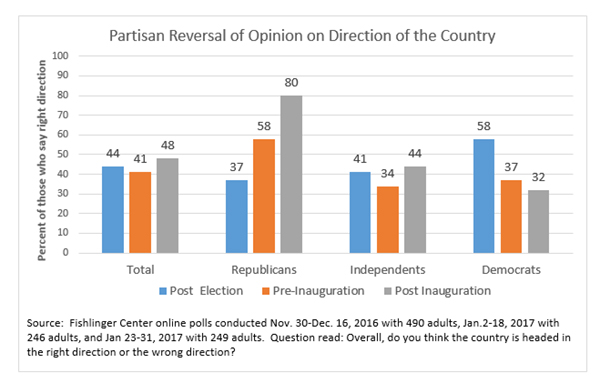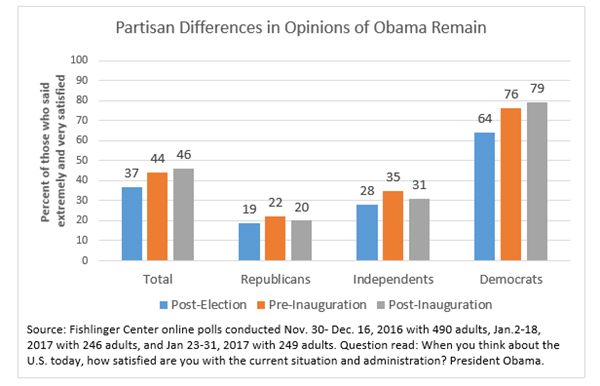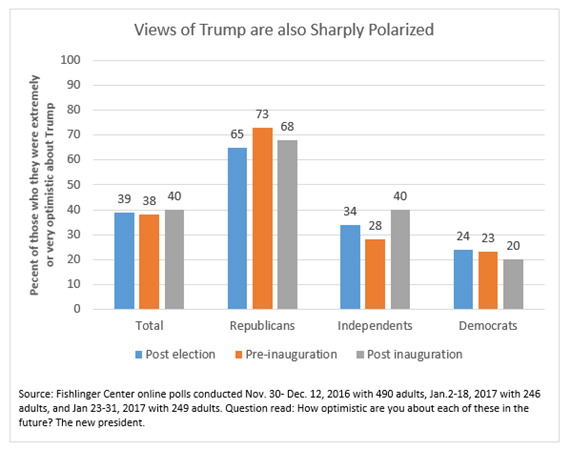Public Sentiment
Post-Inauguration
2/3/2017
In the wake of Inauguration Day and the Women’s March on Washington, there appears to be little change in the public’s attitudes toward the new president. Members of the two major parties remain sharply polarized as they were during Barack Obama’s eight years in office, according to online polls conducted by the Fishlinger Center for Public Policy Research at the University of Mount Saint Vincent.
Independents tend to be in the middle but are showing an increase in optimism following week one of President Donald Trump’s administration. In a reversal of the post-election period, Republicans now see the country as heading in the right direction while Democrats are now much more inclined to regard the country as moving in the wrong direction. Independents remain closely divided.

Satisfaction with former President Barack Obama stabilized for the population as a whole. As been the case throughout most of his presidency, views about the former president are strongly polarized between members of the two major parties.

Concerning optimism about the future, Mr. Trump has also stabilized among the population as a whole. Predictably, the Democrats are not optimistic about the new president, while Republicans continue to have a positive view of the future with Mr. Trump. Independents are slightly more positive than they were before the inauguration. Perhaps they see the administration’s activity during its first week in office as a fulfillment of his campaign promises. This will be an important measure to track as his Presidency unfolds.

Survey Methodology
The Fishlinger Center conducts online national surveys focusing on political issues in the United States. The fieldwork for the polls is conducted using a blended national panel from Survey Sampling Inc. Interviews were conducted November 30, 2016 through December 16, 2016 with 490 adults with a credibility interval of plus or minus 5 percentage points. The surveys conducted January 2, 2017 through January 18, 2017 with 246 adults and January 23, 2017 through January 31, 2017 with 249 adults each have a credibility interval of plus or minus 6 percentage points. It is larger for subgroups and for differences between polls.
In addition to credibility interval, the polls are subject to other potential sources of error including, but not limited to coverage and measurement error. Data were rim weighted to match the national population on age, sex, Hispanic origin and race. Question wording and topline results are available at fishlingercenter@mountsaintvincent.edu.
About the Fishlinger Center for Public Policy
The Fishlinger Center for Public Policy Research opened in February 2015 at the University of Mount Saint Vincent. The Center, a member of the American Association for Public Opinion Research (AAPOR), conducts deep and broad studies of public opinion on key public policy concerns through independent and objective research conducted by students, faculty, and other members of the academic community.
By providing a forum for discourse that can stimulate intelligent dialog about issues that deeply affect all Americans, the Center illustrates and enhances the relationship between the work of the College and the common good.
About the University of Mount Saint Vincent
Founded in 1847 by the Sisters of Charity, the University of Mount Saint Vincent offers nationally recognized liberal arts education and a select array of professional fields of study on a landmark campus overlooking the Hudson River. Committed to the education of the whole person, and enriched by the unparalleled cultural, educational and career opportunities of New York City, the College equips students with the knowledge, skills and experiences necessary for lives of achievement, professional accomplishment and leadership in the 21st century.
